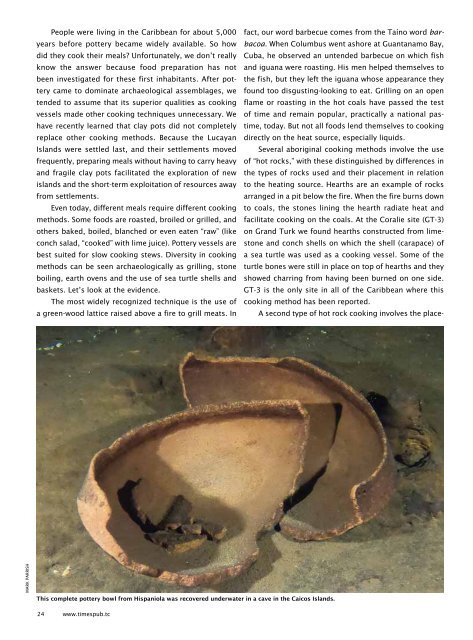Times of the Islands Fall 2021
Presents the "soul of the Turks & Caicos Islands" with in-depth features about local people, culture, history, environment, real estate, businesses, resorts, restaurants and activities.
Presents the "soul of the Turks & Caicos Islands" with in-depth features about local people, culture, history, environment, real estate, businesses, resorts, restaurants and activities.
Create successful ePaper yourself
Turn your PDF publications into a flip-book with our unique Google optimized e-Paper software.
People were living in <strong>the</strong> Caribbean for about 5,000<br />
years before pottery became widely available. So how<br />
did <strong>the</strong>y cook <strong>the</strong>ir meals? Unfortunately, we don’t really<br />
know <strong>the</strong> answer because food preparation has not<br />
been investigated for <strong>the</strong>se first inhabitants. After pottery<br />
came to dominate archaeological assemblages, we<br />
tended to assume that its superior qualities as cooking<br />
vessels made o<strong>the</strong>r cooking techniques unnecessary. We<br />
have recently learned that clay pots did not completely<br />
replace o<strong>the</strong>r cooking methods. Because <strong>the</strong> Lucayan<br />
<strong>Islands</strong> were settled last, and <strong>the</strong>ir settlements moved<br />
frequently, preparing meals without having to carry heavy<br />
and fragile clay pots facilitated <strong>the</strong> exploration <strong>of</strong> new<br />
islands and <strong>the</strong> short-term exploitation <strong>of</strong> resources away<br />
from settlements.<br />
Even today, different meals require different cooking<br />
methods. Some foods are roasted, broiled or grilled, and<br />
o<strong>the</strong>rs baked, boiled, blanched or even eaten “raw” (like<br />
conch salad, “cooked” with lime juice). Pottery vessels are<br />
best suited for slow cooking stews. Diversity in cooking<br />
methods can be seen archaeologically as grilling, stone<br />
boiling, earth ovens and <strong>the</strong> use <strong>of</strong> sea turtle shells and<br />
baskets. Let’s look at <strong>the</strong> evidence.<br />
The most widely recognized technique is <strong>the</strong> use <strong>of</strong><br />
a green-wood lattice raised above a fire to grill meats. In<br />
fact, our word barbecue comes from <strong>the</strong> Taíno word barbacoa.<br />
When Columbus went ashore at Guantanamo Bay,<br />
Cuba, he observed an untended barbecue on which fish<br />
and iguana were roasting. His men helped <strong>the</strong>mselves to<br />
<strong>the</strong> fish, but <strong>the</strong>y left <strong>the</strong> iguana whose appearance <strong>the</strong>y<br />
found too disgusting-looking to eat. Grilling on an open<br />
flame or roasting in <strong>the</strong> hot coals have passed <strong>the</strong> test<br />
<strong>of</strong> time and remain popular, practically a national pastime,<br />
today. But not all foods lend <strong>the</strong>mselves to cooking<br />
directly on <strong>the</strong> heat source, especially liquids.<br />
Several aboriginal cooking methods involve <strong>the</strong> use<br />
<strong>of</strong> “hot rocks,” with <strong>the</strong>se distinguished by differences in<br />
<strong>the</strong> types <strong>of</strong> rocks used and <strong>the</strong>ir placement in relation<br />
to <strong>the</strong> heating source. Hearths are an example <strong>of</strong> rocks<br />
arranged in a pit below <strong>the</strong> fire. When <strong>the</strong> fire burns down<br />
to coals, <strong>the</strong> stones lining <strong>the</strong> hearth radiate heat and<br />
facilitate cooking on <strong>the</strong> coals. At <strong>the</strong> Coralie site (GT-3)<br />
on Grand Turk we found hearths constructed from limestone<br />
and conch shells on which <strong>the</strong> shell (carapace) <strong>of</strong><br />
a sea turtle was used as a cooking vessel. Some <strong>of</strong> <strong>the</strong><br />
turtle bones were still in place on top <strong>of</strong> hearths and <strong>the</strong>y<br />
showed charring from having been burned on one side.<br />
GT-3 is <strong>the</strong> only site in all <strong>of</strong> <strong>the</strong> Caribbean where this<br />
cooking method has been reported.<br />
A second type <strong>of</strong> hot rock cooking involves <strong>the</strong> place-<br />
MARK PARRISH<br />
This complete pottery bowl from Hispaniola was recovered underwater in a cave in <strong>the</strong> Caicos <strong>Islands</strong>.<br />
24 www.timespub.tc

















